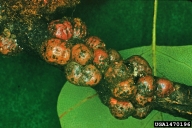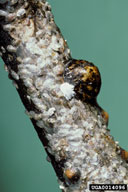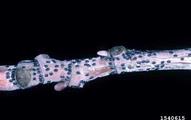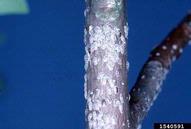Tuliptree scale
Toumeyella liriodendri (Gmelin) (Hemiptera: Coccidae)
Orientation to pest
Tuliptree scale, Toumeyella liriodendri (Gmelin), is native to the eastern United States, where it is widely distributed. It also occurs in urban areas in California, where it is invasive. It mainly feeds on twigs of tuliptree (Liriodendron tulipifera L.) and magnolia (Magnolia). Heavy infestations are common and these can (1) kill seedlings, (2) destroy leaders or branches leading to bushy form, and (3) remove nutrients and lower tree vigor. The scale has one generation per year except in the southern part of its range and it generally overwinters as young nymphs on twigs.
Hosts commonly attacked
This scale feeds on tuliptree (L. tulipifera) and species of magnolia (Magnolia), as well as hosts in eight other plant families.
Distribution
This scale is found from New York south to Florida and west to the Mississippi River (see Burns and Donley [1970] for a distribution map), and has invaded urban areas of California.
Images of tuliptree scale
| Figure 1. Group of mature female tuliptree scales, Toumeyella liriodendri, on twig of host | Figure 2. Mature female of tuliptree scale surrounded by crawlers | Figure 3. Overwintering second instar nymphs of tuliptree scale on twig | Figure 4. Empty cast skins of male "pupae" of tuliptree scale |
Important biological control agents related to this pest species
Many species of parasitoids and predators are reported attacking tuliptree scale in the United States, but at the same time, the scale is reported as frequently being abundant and damaging. Its ability to thrive in spite of its many enemies may be because it is very frequently tended by ants.
Web links for information on tuliptree scale
- Forest Pest Leaflet 92 | USDA Forest Service
- Fact Sheet | Pennsylvania State University Extension
- Fact Sheet | University of Kentucky Cooperative Extension
- Magnolia grandiflora Nursery Production Bulletin | University of Florida IFAS Extension
- Species Catalog on ScaleNet
Complete list of all recorded natural enemies, hosts, and distribution records; also an index to all publications on this species
Articles
- Burns, D. P. and D. E. Donley. 1970. Biology of the tuliptree scale, Toumeyella liriodendri (Homoptera: Coccidae). Annals of the Entomological Society of America 63: 228-235.
- Simpson, J. D. and Lambdin, P. L. 1983. Life history of the tuliptree scale, Toumeyella liriodendri (Gmelin), on yellow-poplar in Tennessee. Tennessee Farm and Home Science 125: 2-5.







